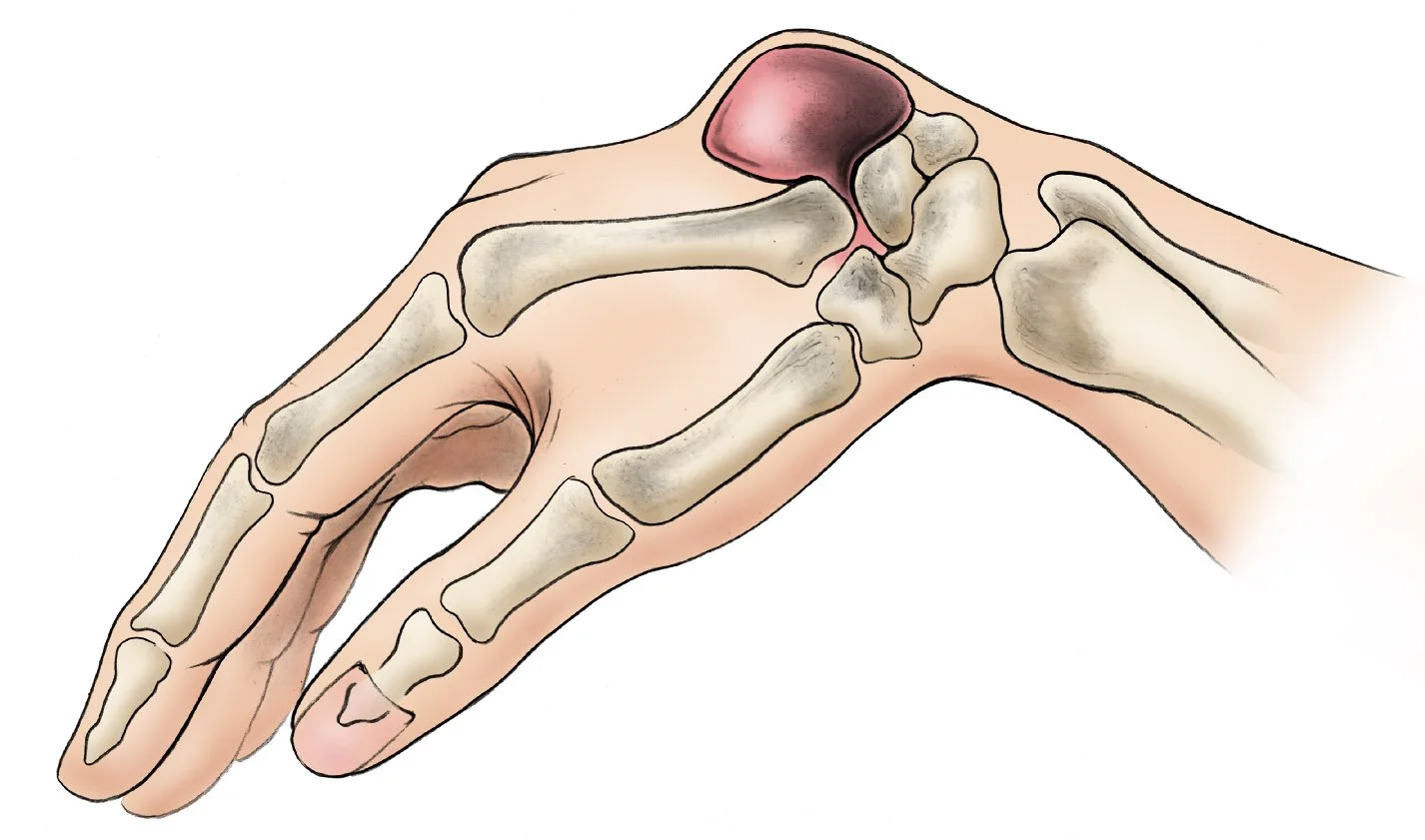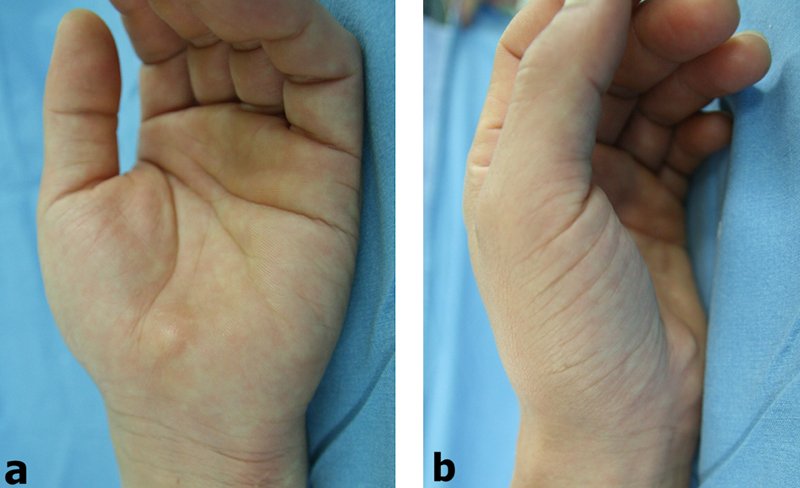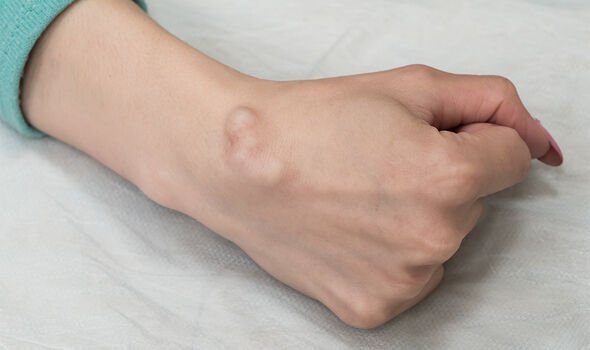Why do I have a bump that feels like a bone?
When a new lump or bump emerges on our hands or wrists, it's natural to wonder about its origins. Is it a sign of a serious condition, or simply a harmless quirk of our body’s complex structure? These protrusions are not merely physical anomalies; they're potential storytellers of our body's history, a fascinating intersection where biology meets the narrative of our lives.
Carpal Boss
The carpal boss, is often discovered as a hard lump on the back of the hand near the wrist (1). It’s an overgrowth of bone or cartilage, asserting itself where the tendons of the hand and wrist flex and move. While its name suggests authority, a carpal boss is usually benign. Its presence may be completely asymptomatic, but for some, it may lead to stiffness or discomfort with certain wrist movements. The causes are not entirely clear, though repetitive strain or a history of trauma could be contributing factors. Managing a carpal boss ranges from non-invasive approaches like rest and immobilization to more definitive treatments like surgical removal for those who experience persistent discomfort or limitation in movement.
Enchondroma
Next, let's spotlight enchondromas, the solitary wanderers within the bones of the hand (2). These benign tumors are made up of cartilage and reside within the bone, often going unnoticed until an incidental x-ray uncovers them. They typically maintain a low profile, but should they grow larger, they may cause discomfort or even lead to a fracture. While they tend to respect the boundaries of their bony home, their presence can compromise bone strength, sometimes necessitating surgical intervention to prevent fractures and maintain the hand’s structural integrity.
Ganglion Cysts
Ganglion cysts are the unpredictable guests in the world of wrist lumps, presenting as round, fluid-filled sacs that arise from a joint or tendon sheath (3). The fluid inside these cysts is similar to the natural lubricant in our joint spaces. Ganglion cysts can vary in size, sometimes fluctuating or disappearing spontaneously, and may cause pain if they compress nearby nerves or structures (4). Their exact cause remains a mystery, although they are often associated with joint or tendon irritation. Treatment can be conservative, such as observation or wrist splints, or more interventional, like aspiration or surgery, especially if they affect hand function or cause significant discomfort.
Inclusion Cysts
Inclusion cysts, particularly epidermoid cysts, are the unassuming neighbors under the skin (5). These dome-shaped bumps are pockets of keratin, the same protein that strengthens our hair and nails. They form when skin cells, rather than shedding normally, burrow inwards. Often, they're innocuous residents that require no treatment. However, if they become inflamed or rupture, they can cause pain and may need to be removed. This is typically a minor procedure, akin to weeding a garden, ensuring that the cyst doesn't return.
Giant Cell Tumors
Giant cell tumors of the bone, while typically benign, are known for their aggressive local behavior (6). They consume bone from the inside out, creating a cavity that can lead to structural weakness. These tumors are generally not wanderers; they remain where they arise, but their penchant for bone destruction can lead to a risk of fractures. When located in the wrist, they can disrupt the complex harmony of hand function. Treatment often involves surgery to remove the tumor and reinforce the bone, sometimes with grafts or bone cement, to preserve the stability and function of the wrist.
Chondrosarcoma
Chondrosarcoma, unlike the other conditions mentioned, is a malignant cancer that begins in the cells that produce cartilage (7). These tumors grow slowly and can go undetected for a long time, often revealing themselves through pain or a noticeable mass. Treatment is challenging due to their resistance to chemotherapy and radiation, making surgical removal a key treatment option. The objective is not just to eliminate the tumor but also to maintain as much function in the affected limb as possible, requiring a skilled orthopedic oncologist to navigate this complex process.
Soft Tissue Sarcomas
Soft tissue sarcomas are the chameleons of the soft tissue world, blending into the background until they're stumbled upon, often unexpectedly. These rare and diverse group of cancers arise from the tissues that connect, support, and surround other body structures. This includes muscle, fat, blood vessels, nerves, tendons, and the lining of your joints. What makes them particularly sly is their ability to start almost anywhere in the body, sometimes making a grand, unwelcome entrance as a lump or swelling in the hand or wrist.
The intrigue with soft tissue sarcomas lies in their unpredictability and diversity. Each sarcoma behaves differently, depending on its specific type and location. Treatment is equally bespoke, tailored to the individual's narrative, involving a multidisciplinary team that might include surgery to remove the interloper, radiation therapy, or chemotherapy.
Dupuytren’s Contracture
Dupuytren’s contracture slowly draws the fingers into a bent position, making tasks like shaking hands or wearing gloves difficult (8). The exact cause is unknown, but it may involve a combination of genetic factors and environmental triggers. Treatment ranges from minimally invasive procedures to break down the contracted tissue, to more extensive surgery in severe cases.
Rheumatoid Arthritis
Rheumatoid arthritis is an autoimmune condition where the body mistakenly attacks its own joint tissue, causing inflammation, pain, and joint damage (9). It often affects the hands first, and while it can be debilitating, there is a range of treatments available. These treatments aim to manage symptoms, reduce inflammation, prevent joint damage, and maintain joint function.
The hands are a marvel of engineering, capable of delicate tasks and powerful grips. Understanding the various conditions that can affect them is crucial for maintaining their health and function. Whether it's a benign overgrowth like a carpal boss or a more serious condition like chondrosarcoma, early detection and appropriate management are key. Our physiotherapy clinic is dedicated to providing the expertise and care needed to navigate these conditions and ensure that your hands remain capable and strong. Remember, your hands tell a story - and we're here to help you keep that story going.
References
American Society for Surgery of the Hand. Carpal Boss. https://www.assh.org/handcare/condition/carpal-boss
Matthew Wells, DO Rajiv Rajani, MD Robert H. Quinn, MD. Enchondroma. 2022. https://orthoinfo.aaos.org/en/diseases--conditions/enchondroma/
Tyler Steven Pidgeon, MD, FAAOS, Charles D. Jennings, MD. April 2022. Ganglion Cyst of the Wrist and Hand. https://orthoinfo.aaos.org/en/diseases--conditions/ganglion-cyst-of-the-wrist-and-hand
American Society for Surgery of the Hand. Ganglion Cysts.https://www.assh.org/handcare/condition/ganglion-cyst
Medline Plus. Ramin Fathi, MD David C. Dugdale, MD, Brenda Conaway. May 2023. Epidermoid cyst. https://medlineplus.gov/ency/article/000842.html
National Institute of Athritis and Musculoskeletal and Skin Disease. November 2022. Rheumatoid Arthritis. https://www.niams.nih.gov/health-topics/rheumatoid-arthritis










